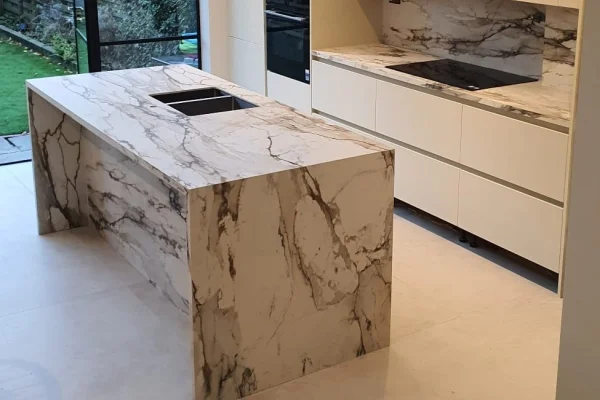Choosing the correct Kitchen Worktop dimensions is essential for ensuring comfort, functionality, and efficiency in your kitchen. A well-designed kitchen layout with appropriately sized worktops can enhance your cooking experience, improve workflow, and even contribute to the overall aesthetics of your space.
The right dimensions depend on several factors, including the user’s height, kitchen size, and intended usage. A Kitchen Worktop that is too high or too low can lead to discomfort and strain, while an inadequate depth may limit workspace efficiency. Additionally, different kitchen layouts—such as L-shaped, U-shaped, or galley kitchens may require varying worktop dimensions to optimize space utilization.
By understanding the standard dimensions and exploring customized options, you can select the perfect Kitchen Worktop that balances practicality and style. Below, we discuss the different aspects of Kitchen Worktop dimensions, from standard sizing to specialized designs for smaller kitchens.
Kitchen Countertop Models
There are various Kitchen Worktop models available, each offering unique benefits in terms of durability, aesthetics, maintenance, and cost. Choosing the right Kitchen Worktop depends on your kitchen’s design, how frequently you cook, and your budget. Some worktops are more resistant to heat and stains, while others require regular maintenance to maintain their beauty. Whether you prefer a natural stone finish, a warm wooden texture, or a modern industrial look, there are plenty of options to suit different styles and needs.
Each Kitchen Worktop material has its own set of advantages and drawbacks, making it crucial to understand their properties before making a decision. Below, we explore some of the most popular Kitchen Worktop models, highlighting their key features, benefits, and potential downsides.
Granite Kitchen Worktops
Granite is a natural stone known for its durability and luxurious appearance. It is resistant to heat and scratches, making it an excellent choice for busy kitchens. However, it requires periodic sealing to maintain its resistance to stains.
Marble Kitchen Worktops
Marble is another natural stone that adds elegance to any kitchen. However, it is more porous than granite, making it more susceptible to stains and scratches. Regular maintenance is essential for a marble
Laminate Kitchen Worktops
Laminate is one of the most budget-friendly Kitchen Worktop options. It is available in various designs and colors, mimicking the look of wood, stone, or metal. However, it is less durable than natural stone or quartz.
Porcelain Kitchen Worktops
Porcelain kitchen worktops have become a top choice for modern kitchens, offering both elegance and durability. Resistant to high temperatures, stains, and scratches, porcelain worktops are the perfect blend of style and functionality. With a wide variety of colors and textures, they seamlessly fit into any kitchen design, enhancing the overall aesthetic. These porcelain worktops are also highly hygienic due to their non-porous surface, preventing the buildup of bacteria. They require minimal maintenance, ensuring long-lasting beauty without compromising performance. Their resistance to heat, water, and chemicals makes them one of the most popular materials in kitchens today.
Crafted with a hygienic design, versatile surface options, and produced using sustainable technology, porcelain redefines innovation. Its exceptional durability resists stains, chemicals, thermal shock, humidity, UV rays, scratches, and abrasions, making it a highly functional and long-lasting choice for a variety of applications.
Acrylic Kitchen Worktops
When it comes to transforming your kitchen with sleek, durable, and easy-to-maintain surfaces, acrylic kitchen worktops are an excellent choice. Known for their smooth, glossy finish and variety of vibrant colors, acrylic worktops offer a contemporary aesthetic that complements any kitchen style.
Acrylic kitchen worktops are an ideal solution for homeowners looking to blend style, durability, and functionality. Whether renovating an existing kitchen or designing a new one, these surfaces offer a sleek and long-lasting option that meets both aesthetic and practical needs.
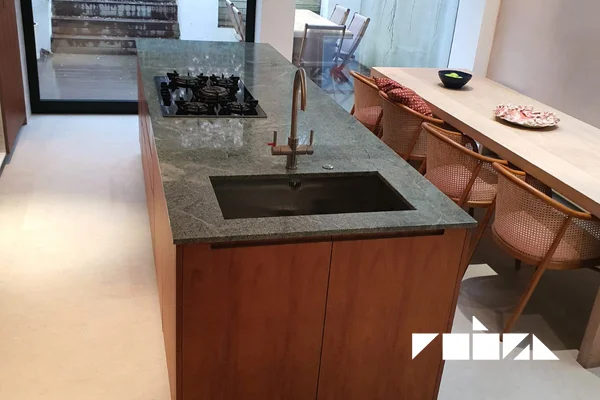
Terrazzo Kitchen Worktops
Terrazzo kitchen worktops are gaining popularity for their unique aesthetic and durable properties. Made from a mix of marble, quartz, granite, and glass chips set in cement or resin, terrazzo offers a distinctive speckled look that adds elegance and character to any kitchen.
Terrazzo worktops are not only stylish but also practical. They are highly resistant to stains, heat, and scratches, making them an excellent choice for busy kitchens. Their seamless finish and variety of color combinations allow homeowners to customize their kitchen according to their design preferences.
If you’re looking for a stylish and long-lasting surface, terrazzo kitchen worktops are an excellent investment. Their timeless appeal, durability, and eco-friendly properties make them a perfect addition to any modern kitchen.
Quartz Kitchen Worktops
Quartz kitchen worktops are a top choice for homeowners seeking a combination of elegance, durability, and low maintenance. Made from engineered stone composed of natural quartz crystals and resin, these worktops offer a non-porous, stain-resistant, and highly durable surface that suits both modern and traditional kitchens.
Quartz worktops provide a luxurious and sophisticated look while offering unmatched practicality. Unlike natural stones like granite or marble, quartz does not require sealing and is resistant to stains, scratches, and bacteria.
What Are the Right Kitchen Countertop Dimensions for Your Home?
Choosing the correct Kitchen Worktop dimensions is essential for ensuring comfort, functionality, and efficiency in your kitchen. The right size will not only enhance the kitchen’s usability but also improve ergonomics, preventing strain while cooking or preparing meals. A well-proportioned Kitchen Worktop allows for smooth workflow, providing enough space for food preparation, storage, and even small appliances without making the kitchen feel overcrowded.
When selecting the ideal Kitchen Worktop dimensions, factors such as the height, depth, and thickness of the surface should be taken into account. Standard dimensions work well for most kitchens, but custom sizes may be necessary for unique layouts or specialized needs. Additionally, considering the available space and how the worktop integrates with kitchen cabinets and appliances will ensure a more cohesive and functional kitchen design.
Standard Kitchen Worktop Dimensions
The standard height of a Kitchen Worktop is approximately 90 cm, with a depth of 60 cm. These dimensions are carefully designed to provide a comfortable working height for most users, allowing for ease of food preparation, cooking, and cleaning. The height ensures minimal strain on the back and shoulders while working in the kitchen.
However, these standard dimensions may not be suitable for everyone. Taller individuals may find a Kitchen Worktop at 90 cm too low, leading to discomfort over time, while shorter individuals may prefer a slightly lower worktop to ensure better control while handling kitchen tasks. Depth is also an important consideration, as a Kitchen Worktop that is too shallow may not provide enough space for appliances and cooking prep, while a deeper counter can reduce accessibility.
For an ideal kitchen layout, it’s important to consider these dimensions in relation to cabinetry, sink placement, and stove positioning to ensure a seamless and ergonomic kitchen workflow.
Custom-Made Kitchen Worktops
For homeowners with unique kitchen layouts, specific ergonomic needs, or personal design preferences, custom-made Kitchen Worktop solutions offer a perfect alternative. These can be tailored in terms of size, thickness, material, and shape to fit any kitchen space, ensuring both functionality and aesthetic appeal.
Some kitchens require custom worktops due to irregular layouts, such as L-shaped or U-shaped designs, or to accommodate unique elements like a built-in stovetop or an integrated sink. Custom Kitchen Worktop solutions also allow homeowners to choose the exact height that suits their comfort, which is particularly useful for individuals who find standard worktops too high or too low.
Additionally, the width and depth of a Kitchen Worktop can be adjusted based on available space. For instance, larger kitchens may benefit from deeper worktops (up to 75 cm or more), which provide more prep area, while compact kitchens might require narrower worktops (around 50 cm) to maximize walking space.
Choosing a custom Kitchen Worktop is ideal for those looking to blend aesthetics and functionality while optimizing their kitchen’s design and layout.
Thickness and Edge Profiles
The thickness of a Kitchen Worktop generally ranges from 2 cm to 4 cm, with each thickness offering distinct advantages in terms of durability and design.
- 2 cm thickness – Provides a sleek, modern look, often seen in contemporary kitchen designs. This thinner profile is ideal for minimalist styles but may require additional support in some installations.
- 3 cm thickness – A popular choice as it balances durability and style, making it sturdy enough for daily kitchen activities while maintaining a refined appearance.
- 4 cm thickness and above – Creates a bold, luxurious look and is commonly used in high-end traditional kitchen designs. It enhances the visual impact of natural stone worktops like granite or marble.
Aside from thickness, edge profiles also play a crucial role in the Kitchen Worktop’s final look. Some popular edge designs include:
- Beveled Edge – A subtle, angled cut that adds a touch of elegance.
- Bullnose Edge – A fully rounded edge that enhances safety, especially in homes with children.
- Straight Edge – A simple, clean-cut edge that complements modern kitchens.
- Waterfall Edge – Extends the material vertically down the side of the cabinetry, creating a seamless, high-end appearance.
Selecting the right thickness and edge profile for your Kitchen Worktop will depend on your kitchen’s overall design theme, your functional needs, and your budget.
Space Optimization for Small Kitchens
In smaller kitchens, maximizing counter space is essential to create an efficient cooking environment. Choosing the right Kitchen Worktop can significantly impact how functional and spacious your kitchen feels.
Some effective space-saving Kitchen Worktop solutions include:
- Foldable Extensions – These allow you to expand counter space when needed and fold them down when not in use, making them ideal for small kitchens or apartments.
- Pull-Out Worktops – Hidden worktops that slide out from underneath existing counters or cabinets can provide extra prep space without taking up permanent room.
- Integrated Cutting Boards – Worktops with built-in cutting boards help save space and reduce clutter on the counter.
- Multifunctional Worktops – Some Kitchen Worktops come with built-in sinks, induction cooktops, or storage compartments, reducing the need for separate appliances or storage solutions.
When working with a small kitchen, selecting a lighter-colored Kitchen Worktop can also help create the illusion of more space. Additionally, glossy finishes reflect light better, making the area feel brighter and more open.
Best Worktop Heights for Comfort and Ergonomics
The height of your Kitchen Worktop should be chosen with ergonomics in mind to ensure long-term comfort and ease of use. Standard worktops are set at 90 cm, but this may not be the ideal height for everyone.
Here’s how you can determine the best height for your Kitchen Worktop based on your needs:
- For Taller Individuals (Over 180 cm) – A worktop height of 95 cm to 100 cm is recommended to prevent excessive bending and back strain.
- For Shorter Individuals (Below 160 cm) – Lowering the worktop height to 85 cm may provide a more comfortable working level.
- For Universal Comfort – Adjustable-height worktops or split-level counters (with different heights for prep, cooking, and dining areas) can provide flexibility for households with multiple users of varying heights.
Additionally, if you frequently bake or prepare meals that require rolling dough, a slightly lower Kitchen Worktop in one section can make these tasks easier. Similarly, having a raised worktop area near the stove can provide a better view while cooking.
By customizing the height of your Kitchen Worktop, you can significantly enhance your comfort, reduce strain, and make your kitchen more efficient for everyday use.
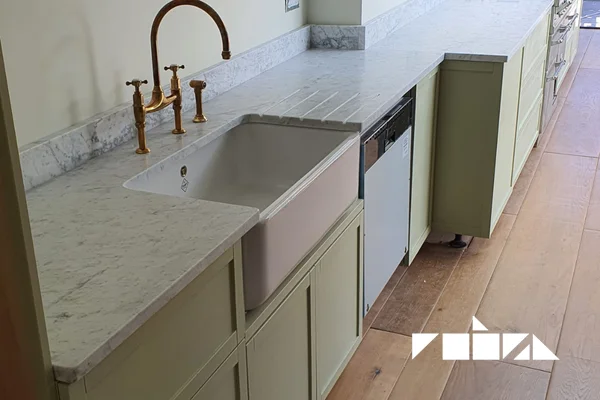
Budget Friendly Kitchen Worktops
When designing or renovating a kitchen, choosing the right Kitchen Worktop is essential for both aesthetics and functionality. However, high-end materials like granite and marble can be costly, making it challenging for homeowners on a budget. The good news is that there are plenty of budget-friendly Kitchen Worktop options available that offer durability, style, and affordability without compromising on quality.
Whether you're renovating your entire kitchen or simply updating your Kitchen Worktop, making an informed decision will help you get the best value for your money while maintaining a stylish and functional space.
Things to Consider When Choosing a Kitchen Worktop
Choosing the right Kitchen Worktop is one of the most important decisions when designing or renovating a kitchen. The worktop is the heart of the kitchen, serving as a workspace for meal preparation, a place for appliances, and even a dining area in some homes. It must be durable, stylish, and functional while complementing the overall kitchen design.
With so many materials, finishes, and styles available, selecting the best Kitchen Worktop can be overwhelming. To make the decision easier, here are the key factors to consider before making a purchase.
Durability and Resistance to Scratches and Stains
A Kitchen Worktop must be able to withstand daily use, including cutting, chopping, hot cookware, and spills. Different materials offer varying levels of durability:
- Quartz and Granite: Highly durable and resistant to scratches and stains. Ideal for busy kitchens.
- Laminate: Affordable but more prone to scratches and heat damage.
For a long-lasting Kitchen Worktop, choose a material that resists wear and tear while maintaining its appearance over time.
Heat and Moisture Resistance
Kitchens are high-moisture environments with frequent exposure to heat from stoves, ovens, and hot pots. Choosing a Kitchen Worktop that is heat- and moisture-resistant is crucial:
- Granite and Quartz: Naturally heat-resistant and do not absorb water.
- Laminate: Can be damaged by excessive heat but resists moisture.
- Marble: Heat-resistant but porous, making it susceptible to moisture damage if not sealed.
If you do a lot of cooking, opt for a Kitchen Worktop that can handle high temperatures without warping or discoloration.
Aesthetic Appeal and Matching with Kitchen Décor
Your Kitchen Worktop should complement the overall design and theme of your kitchen. Whether you prefer a modern, rustic, or classic look, there’s a worktop material to match:
- Minimalist & Modern Kitchens: Quartz or polished granite work well.
- Traditional & Farmhouse Kitchens: Marble create a warm and inviting feel.
- Industrial-Style Kitchens: Concrete or urban aesthetic.
- Luxury Kitchens: High-end materials like marble, granite, or quartz with waterfall edges can enhance elegance.
Consider the color, pattern, and texture of the Kitchen Worktop to ensure it blends well with your cabinets, flooring, and backsplash.
Ease of Cleaning and Maintenance
A Kitchen Worktop should be easy to clean and maintain, ensuring hygiene and longevity. Some materials require minimal upkeep, while others demand regular care:
- Low-Maintenance Options: Quartz, stainless steel, and laminate require simple cleaning with mild soap and water.
- High-Maintenance Options: Marble and wood need frequent sealing and special care to prevent stains, scratches, and moisture absorption.
- Tile Worktops: Durable but require grout cleaning to prevent dirt buildup.
If you prefer a hassle-free Kitchen Worktop, opt for a non-porous material that resists stains and does not require sealing.
Environmental and Sustainable Worktop Options
For eco-conscious homeowners, sustainable and environmentally friendly Kitchen Worktop materials are available:
- Recycled Glass Worktops: Made from crushed glass embedded in resin or concrete, offering a unique and eco-friendly look.
- Composite Worktops: Made from recycled materials and designed to be highly durable and sustainable.
Choosing a sustainable Kitchen Worktop helps reduce your environmental impact while maintaining style and durability.
Installation Process and Costs
The installation process varies depending on the Kitchen Worktop material. Some materials, like laminate, are easier to install, while others require professional expertise:
- DIY-Friendly Materials: Laminate, tile, and wood can be installed by homeowners with basic skills.
- Requires Professional Installation: Quartz, granite, marble, and stainless steel need expert handling due to weight and precision cutting.
Choosing the right Kitchen Worktop is about finding the perfect balance between durability, aesthetics, maintenance, budget, and functionality. Whether you prefer a luxurious marble worktop, a budget-friendly laminate option, or an eco-friendly recycled glass surface, there’s a solution to match your needs.
By considering factors like heat resistance, scratch durability, maintenance requirements, and kitchen workflow, you can select a Kitchen Worktop that enhances your kitchen’s style and usability for years to come.
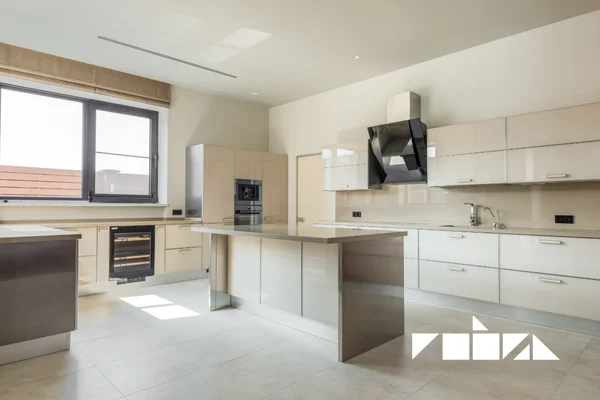
Kitchen Worktop Prices
When planning a kitchen renovation or upgrade, one of the most important considerations is the Kitchen Worktop. The worktop is not only a functional workspace but also a major design element that affects the overall aesthetics of your kitchen. However, Kitchen Worktop prices can vary significantly based on several factors, making it essential to understand what influences cost and how to get the best value for your investment.
Choosing the right Kitchen Worktop involves balancing budget, durability, maintenance, and design preferences. While some materials offer luxury and long-term durability, others provide a more budget-friendly solution without compromising on style.
Factors That Influence Kitchen Worktop Prices
The price of a Kitchen Worktop is determined by various factors, including material type, thickness, customization, and installation. Understanding these factors can help you make an informed decision and stay within budget.
Material Type
The most significant factor affecting the cost of a Kitchen Worktop is the material used. Some materials are naturally more expensive due to their sourcing, durability, and appearance. Popular materials include:
- Quartz – A premium engineered stone that offers high durability, stain resistance, and a sleek, modern look.
- Granite – A natural stone known for its luxurious appearance and durability.
- Marble – A high-end material with a timeless look but requires more maintenance.
- Laminate – A budget-friendly option that mimics the look of wood or stone.
- Concrete – A modern, customizable option that adds a unique aesthetic.
Each material has its advantages and price points, so consider both the initial cost and long-term maintenance when choosing the right Kitchen Worktop.
Worktop Thickness and Size
The thickness and size of the Kitchen Worktop also play a crucial role in determining the overall price. Standard thicknesses range from 2 cm to 4 cm, with thicker worktops generally costing more due to the additional material required.
Larger kitchens with extended countertop areas will naturally have higher costs, as more material is needed. If you have a kitchen island or require custom-cut worktops for an irregular space, expect additional expenses.
Customization and Design Features
Custom features and special design elements can increase the price of a Kitchen Worktop. These include:
- Custom edge profiles – Standard edges are included in most worktops, but decorative edges (such as bullnose, beveled, or waterfall edges) may come at an extra cost.
- Integrated sinks and drainboards – Some worktops can be custom-fitted with integrated sinks, enhancing aesthetics and functionality.
- Color and pattern selection – Unique colors, rare natural stone patterns, or custom finishes can drive up the cost.
- Sealing and protective coatings – Some materials, like marble and wood, require sealing to prevent stains and water damage, adding to the overall expense.
While customization adds personality to your Kitchen Worktop, it’s important to balance aesthetics with budget considerations.
Installation Costs
The installation process is another factor that influences the final cost of a Kitchen Worktop. Some materials are easier to install and may be suitable for DIY installation, while others require professional expertise.
- Easy-to-install worktops: Laminate and wood worktops are relatively easy to install, reducing labor costs.
- Requires professional installation: Quartz, granite, marble, and concrete worktops are heavy and require precise cutting, increasing installation expenses.
Additional installation costs may include cutting, edging, sealing, and transportation fees, depending on the complexity of the project.
Maintenance and Long-Term Costs
Beyond the initial price, it’s essential to consider the long-term maintenance costs of a Kitchen Worktop. Some materials require frequent upkeep, which can add to the overall expense over time.
- Low-maintenance worktops – Quartz, stainless steel, and laminate require minimal care, making them cost-effective in the long run.
- High-maintenance worktops – Marble and wood require regular sealing, polishing, and special cleaning products, which may increase long-term costs.
If you prefer a low-maintenance Kitchen Worktop, opt for a material that resists stains, heat, and scratches, reducing future expenses.
How to Get the Best Deal on a Kitchen Worktop
If you’re looking to save money while still getting a high-quality Kitchen Worktop, there are several budget-friendly strategies you can use. One of the most effective ways to reduce costs is by comparing prices from multiple suppliers. Since different retailers offer varying prices, it’s always a good idea to get quotes from local suppliers, online stores, and wholesale dealers to find the best deal. Additionally, opting for standard sizes and prefabricated worktops instead of custom-cut options can help you save on material and installation fees. Prefabricated worktops come in common sizes, reducing the need for expensive customization and labor costs.
Another great way to cut costs is by shopping during seasonal discounts and sales. Many home improvement stores offer promotions during holiday sales, clearance events, or end-of-season discounts, making it the perfect time to purchase a Kitchen Worktop at a lower price. If your preferred worktop material is beyond your budget, consider an alternative material that mimics the look of high-end surfaces. For example, laminate worktops can replicate the appearance of granite or wood at a fraction of the cost while still offering durability and style.
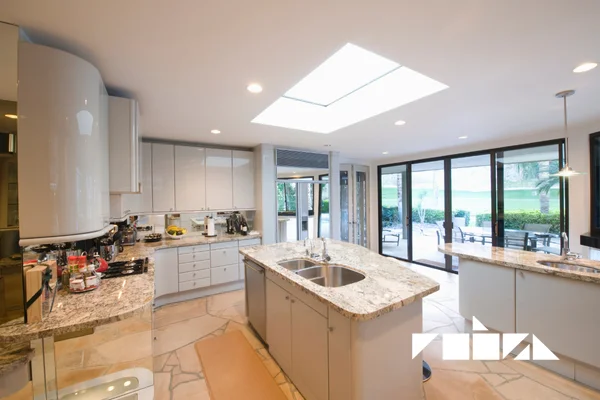
For those with basic home improvement skills, DIY installation can be a cost-effective solution. While materials like laminate and wood are easy to install, heavier materials such as granite or quartz require professional expertise to ensure a flawless finish. If you want to achieve a luxurious look without overspending, consider using mixed materials in different areas of the kitchen. A high-end Kitchen Worktop, such as quartz, can be used for the island, while a more affordable laminate or wood worktop can be installed in other areas to balance cost and style.
The price of a Kitchen Worktop depends on several factors, including material type, size, customization, and installation. Whether you’re looking for an affordable laminate worktop, a durable quartz countertop, or a luxurious marble surface, understanding these factors will help you make an informed decision. By comparing prices, choosing standard sizes, and considering cost-effective alternatives, you can invest in a Kitchen Worktop that not only fits your budget but also enhances the beauty and functionality of your kitchen.
Why Robel is the Best Choice for Your Kitchen Worktop Needs
When it comes to finding a high-quality, durable, and stylish Kitchen Worktop, Robel stands out as a trusted provider. With a wide range of materials, from quartz and granite to budget-friendly laminate and wood, we offer options to suit every kitchen style and budget. Our expert craftsmanship, premium materials, and competitive prices ensure that you get the perfect Kitchen Worktop without compromise.
At Robel, we prioritize durability, aesthetics, and functionality, providing custom solutions tailored to your space. Whether you're looking for a modern, minimalist design or a classic, timeless finish, our Kitchen Worktop collection has something for everyone. Plus, with our professional installation services and excellent customer support, you can enjoy a hassle-free experience from selection to installation.
Upgrade your kitchen with Robel’s Kitchen Worktops and experience superior quality, style, and long-lasting performance. Contact us today to find the perfect Kitchen Worktop for your home!




